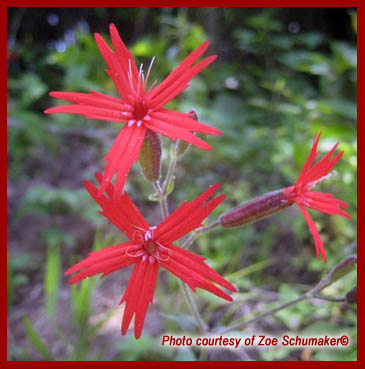An Uncommon Red Star
By Geri O’Brien, Plant Preservation Team
Of the many wildflowers in bloom now, one of the most conspicuous is the little fire pink, Silene virginica. It is the bright red color,  not size that is eye-catching.
not size that is eye-catching.
“Pink” in the name does not refer to color, but to the notched edge of the five small narrow petals, perhaps named by someone familiar with pinking shears used in tailoring. The red petals extend into a narrow tube filled with nectar. With no obvious odor, and no landing pad for bees and butterflies, the flower is a favorite of its major pollinator, the Ruby-throated Hummingbird.
Fire pink has blade shaped leaves that are in opposite, paired positions on the weak round stem, which grows to a height of one to two feet. Both the stems and leaves are covered in short sticky hairs that keep small crawling insects from reaching the nectar in the flower. The sticky hairs also explain why hummingbirds, who do not need to land, are the pollinators, and account for the common name, catchfly.
Blooms begin appearing in late spring and continue into midsummer. While fire pink is considered to be pretty rare, it has a widespread area in the forests, slopes, meadows and roadsides across most of the eastern half of the United States. It tolerates partial shade, dry conditions and poor, rocky soil. In this area, it is one of the wildflowers often seen along mountain highways.
While perennials are generally thought to be everlasting, fire pink may live only two or three years. Fortunately, it may reproduce from seeds. Seed pods contain up to six seeds which are food for a variety of birds, including juncos and sparrows, which aid in the distribution of the plant.
A search for information about chemical properties of fire pink revealed little except that American Indians considered the plant poisonous. Herb doctors used it as a worm medicine and made a tonic to soothe nervous anxiety. More recent studies indicate slight bacterial inhibition. While some members of the Silene genus are known to contain chemicals that affect the molting of insects and are widely studied for insect control, fire pink is not currently listed as such.
The name “Silene” is ancient, dating back to Greek mythology. In relation to this plant name, it likely means “sticky,” although who gave the name and when remains unknown. The idea of a woodland spirit, dignified and musical, is somehow fitting for this crimson
star of the native flora of Southern Appalachia.
![]()
Sign
up for the Blue Ridge Highlander Newsletter, Messages from the Mountains
to find out first about our new feature stories, road trips and special offers
Your e-mail addresses will not be sold or given away to anyone.
Privacy
Policy
Interested in your business being on the Highlander, click here...
Let our visitors tell you about the Highlander...
Click the feathers to go to the Highlander site
map...

